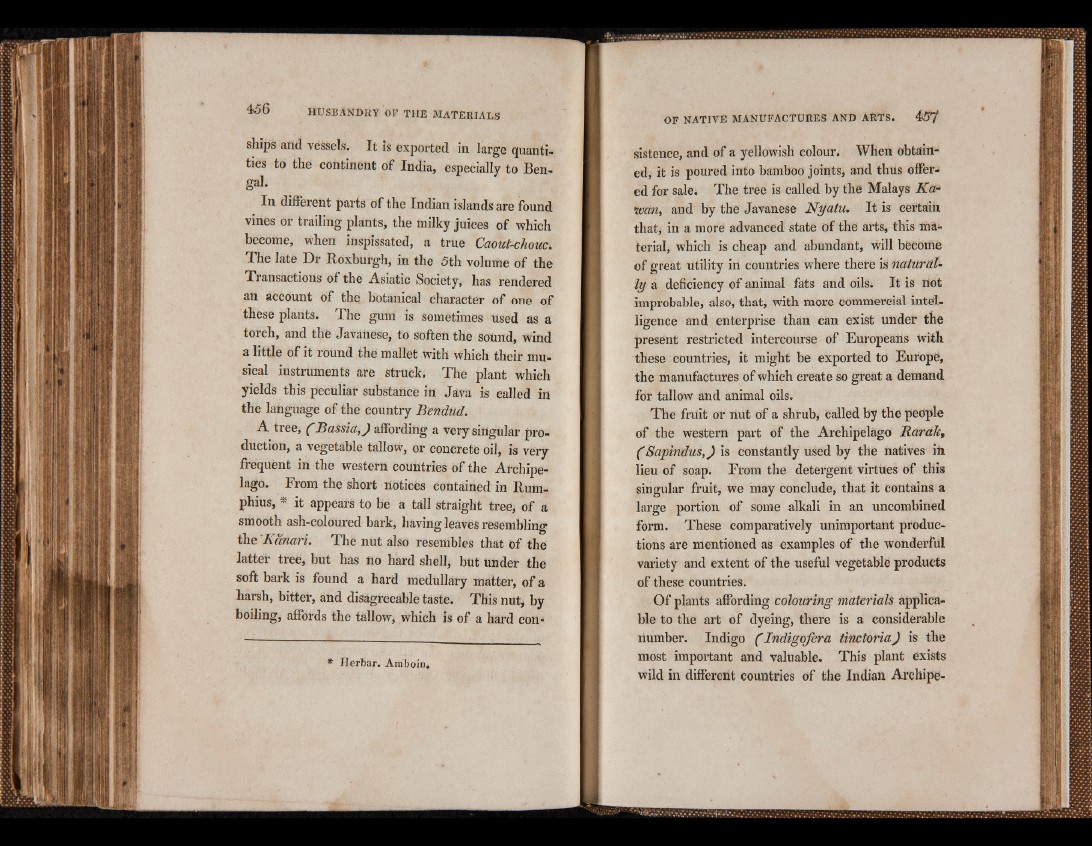
ships and vessels. It is exported in large quantities
to the continent of India, especially to Bengal.
In different parts of the Indian islands are found
vines or trailing plants, the milky juices of which
become, when inspissated, a true Caout-chouc.
The late Dr Roxburgh, in the 5th volume of the
Transactions of the Asiatic Society, has rendered
an account of the botanical character of one of
these plants. The gum is sometimes used as a
torch, and the Javanese, to soften the sound, wind
a little of it round the mallet with which their musical
instruments are struck. The plant which
yields this peculiar substance in Java, is called in
the language of the country Bendud.
A tree, ( Bassia,J affording a very singular production,
a vegetable tallow, or concrete oil, is very
frequent in the western countries of the Archipelago.
From the short notices contained in Rum-
phius, * it appears to be a tall straight tree, of a
smooth ash-coloured bark, having leaves resembling
the Kanari. The nut also resembles that of the
latter tree, but has Uo hard shell, but under the
soft bark is found a hard medullary matter, of a
harsh, bitter, and disagreeable taste. This nut, by
boiling, affords the tallow, which is of a hard con*
Herbar. Amboin.
sistence, and of a yellowish colour. When obtained,
it is poured into bamboo joints, and thus offered
for sale. The tree is called by the Malays Ka-
wtin, and by the Javanese Nyatu. It is certain
that, in a more advanced state of the arts, this material,
which is cheap and abundant, will become
of great utility in countries where there is natural-
ly a deficiency of animal fats and oils. It is not
improbable, also, that, with more commercial intelligence
and enterprise than can exist under the
present restricted intercourse of Europeans with
these countries, it might be exported to Europe,
the manufactures of which create so great a demand
for tallow and animal oils.
The frUit or nut of a shrub, Called by the people
of the western part of the Archipelago Rarakt
( Sapindus,) is constantly used by the natives in
lieu of soap. From the detergent virtues of this
singular fruit, we may conclude, that it contains a
large portion of some alkali in an uncombined
form. These comparatively unimportant productions
are mentioned as examples of the wonderful
variety and extent of the useful vegetable products
of these countries.
Of plants affording colouring materials applicable
to the art of dyeing, there is a considerable
number. Indigo (Indigofera tinctoriaj is the
most important and valuable. This plant exists
wild in different countries of the Indian Archipe